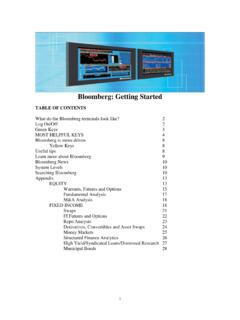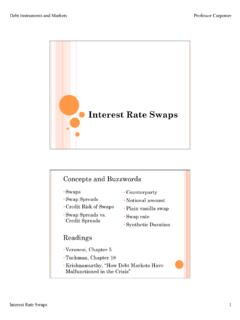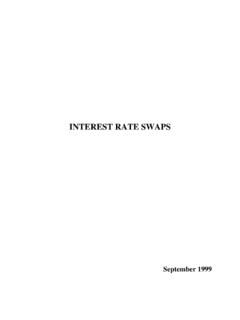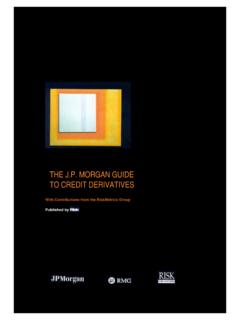Transcription of Understanding and modelling swap spreads - Jan Röman
1 407 IntroductionA swap is an agreement between two parties to exchangecash flows in the future. The most common type ofinterest rate swap is a plain vanilla fixed-for-floating interest rate swap(1)where one party wants to receivefloating (variable) interest rate payments over a givenperiod, and is prepared to pay the other party a fixedrate to receive those floating payments. The floatingrate is agreed in advance with reference to a specificshort-term market rate (usually three-month or six-month Libor).(2)The fixed rate is called the swap rateand should reflect, among other things, the value eachparty attributes to the series of floating-rate payments tobe made over the life of the contract.
2 Swap marketsserve as a link between government debt, corporate debtand money markets, across currencies (via basis swaps )(3)and between swap rates and government bondyields of the same maturity are referred to as swapspreads. If the swap and government bond markets arepriced efficiently, swap spreads may reveal somethingabout the perception of the systemic risk of the bankingsector. This is because the risk of the systemic failure ofthe banking sector is embedded in Libor rates . Ifhowever, the swap and government markets are notpriced efficiently at all times, swap spreads may bealtered by perceptions of the economic outlook andsupply and demand imbalances in both the swap andthe government bond markets.
3 The volume of swap transactions has increased rapidly in recent years (see Chart 1). swaps are the largest type of traded interest rate derivatives in the OTC (over-the-counter)(4)market, accounting for over 75% ofUnderstanding and modelling swap spreadsInterest rate swap agreements were developed for the transfer of interest rate risk. Volumes have grownrapidly in recent years and now the swap market not only fulfils this purpose, but is also used to extractinformation about market expectations and to provide benchmark rates against which to compare returnson fixed-income securities such as corporate and government bonds.
4 This article explains what swapsare; what information might be extracted from them; and what appear to have been the main drivers ofswap spreads in recent years. Some quantitative relationships are explored using ten-year swap spreadsin the United States and the United Kingdom as Cortes of the Bank s Foreign Exchange Division.(1) Another common type of swap is a currency swap involving the exchange of principal and interest payments in onecurrency for principal and interest payments in another currency.(2) The London Interbank Offered Rate (Libor) is a measure of the interest rate at which banks borrow funds from otherbanks in the London interbank market.
5 US dollar and sterling Libor rates are determined each day by averaging overa panel of banks determined by the British Bankers Association. The euro area has a similar interbank rate, calledEuribor.(3) A basis swap is an interest rate swap carried out between two floating rates set against two different reference cash flows ( interest payments) exchanged are calculated from two floating-rate indices which might differ bycurrency and/or by instrument, eg Libor, certificate of deposit or Treasury bill.(4) Over-the-counter means an asset that is not traded on an exchange but traded as a result of direct negotiationbetween buyers and 1 OTCinterest rate contracts by instrument in allcurrencies0102030405060708090 JuneDec.
6 June Dec. JuneDec. JuneDec. interest rate swaps outstandingTotal forward-rate agreements outstandingTotal option contracts outstanding US$ trillions19 989 920000102 Source: of England Quarterly Bulletin:Winter 2003the total amount traded of these contracts.(1)Initiallydeveloped as a means of allowing institutions to manageinterest rate exposures on their asset and liabilityportfolios more effectively, more recent demand hascome from hedging and speculative sources. One recentsource of demand for hedging mortgage-backedsecurity portfolios will be discussed illustrate how interest rate swaps can be used tomanage interest rate risk, suppose that an institution hasfloating-rate liabilities (debt), and that it pays 5 basispoints over a reference rate such as three-month Libor,but has fixed-rate paying assets.
7 Should interest ratesrise, it will be paying out more via its floating debtpayments but its fixed-rate asset income will remain thesame, ie it will incur a loss. To reduce this interest raterisk exposure, the institution can enter into a swapwhere it pays a fixed rate, and receives a floating rate. Asinterest rates rise, part of the gap between its floating-rate payments and its fixed-rate income will beclosed by its incoming floating-rate coupons. The keyidea is that an institution can syntheticallycreate eitherfixed or floating-rate assets via a swap fixed leg in a swap can be thought of as a fixed-ratebond trading at par and paying a coupon equal to theswap rate, that is, the swap rate is equivalent to a paryield.
8 (2)The large volume of swap contracts outstandingimplies that par yields of swaps are easily obtainable fordifferent maturities allowing market participants to buildand use swap yield curves. Indeed, swap yield curveshave become popular as benchmarks against whichmarket participants can assess the returns on their(fixed-income) assets.(3)The theory: fair value of swap spreadsCompared with a government bond yield curve, the swapyield curve also reflects expectations of the future spreadbetween the relevant Libor rate and the generalcollateral (GC) repo rate(4)of equivalent maturity.
9 (5)ThisLibor-GC repo spread should reflect the premium thatinvestors require to compensate them for the probabilityof a systemic failure of the banking sector. Thispremium would be embedded in the Libor rate, but it isnot present in the GC repo rate. We note, however, thatthere is survivorship bias in the Libor indices; the riskof an individual bank defaulting has an almost negligibleimpact on Libor and hence on swap rates since bankswhose credit rating deteriorates drop from the , in theory, the fair value of the swap spread shouldencapsulate the compensation required by interbanklenders to offset expected losses on a series of rollingunsecured loans (referenced to Libor) over the life of theswap.
10 This relies on there being a close relationshipbetween expectations of future Libor-GC repo spreadsand the swap spread, and there is some evidence tosuggest that this relationship does not hold closely inpractice. By way of example, Chart 2 plots the currentthree-month Libor-GC repo spread against the US dollarten-year swap spread. Chart 2 shows that the US dollar ten-year swap spreaddisplays persistent deviations from the Libor-GC repospread, while the latter seems to revert quickly to itslong-run average, having been affected by short-rundisruptions such as the three months prior to theMillennium.













